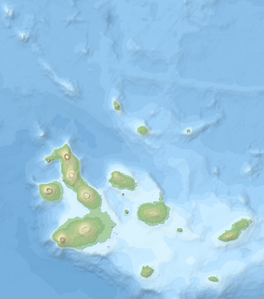Isla Darwin (Galápagos)
| Isla Darwin (Culpepper Island) | ||
|---|---|---|
| Waters | Pacific Ocean | |
| Archipelago | Galapagos Islands | |
| Geographical location | 1 ° 39 '24 " N , 92 ° 0' 19" W | |
|
|
||
| length | 1.2 km | |
| width | 800 m | |
| surface | 1.1 km² | |
| Highest elevation | 165 m | |
| Residents | uninhabited | |
| Darwin's Arch , a cliff off the island | ||
Darwin Island (English Culpepper Iceland ) is an uninhabited island , which in the extreme northwest of the to Ecuador belonging Galapagos Islands located and with an area of about 1, the northernmost and westernmost island km² same time the almost archipelago is. It was named after Charles Darwin and was created around 700,000 years ago. The closest island is Wolf and is 34 km further south. Many seals , marine iguanas , sea turtles and numerous bird species live on the island, including the vampire finches .
natural reserve
The island is under extensive protection by the national park administration, entry is strictly forbidden, special permits for scientists or film teams have rarely been granted in recent years. Local fishermen can acquire fishing licenses that are limited in time and quantity, but are only allowed to use fishing rods , not nets and certainly not with long lines .
About 2 km southeast of the island around the cliffs on the rock in front of Darwin's Arch is one of the most interesting diving areas in the world. It is particularly known for the large schools of hammerhead sharks , which often include over 200 animals here, but also other large fish such as manta rays , eagle rays , cow nosed rays , reef sharks , whale sharks can be observed here in large numbers. The very fish-rich waters around the island are inhabited by large dolphin populations (various subspecies), orcas and other whales often pass by.
There are also strict rules for recreational divers ; only a few tour operators are granted licenses.
Regular patrols by the national park administration and the Ecuadorian coast guard are intended to ensure that fishermen and divers observe the rules.
Web links
- Image of the island
- Islas Wolf and Darwin , Cornell University (English speaking)
Individual evidence
- ^ Volcanic Galapagos (accessed January 5, 2013).

